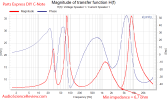Thanks for the test Amir!

Actually a pretty cute and nice looking NAD.

Too bad it seems to get so hot. But is it very hot? Doesn't it wear hard on the electronics? Reduced lifespan of the capacitors in it?
Those class AB based amplifiers designed by Bjorn Erik Edvardsen seem to deliver good results, so does this one:
This is a review and detailed measurements of the NAD C 320BEE power (speaker) amplifier. It is on kind loan. The C 320BEE is a vintage product, dating back to 2003 I think. The BEE designation is apparently a reference to Bjorn Erik Edvardsen who was one of their designers. Can't tell if he...

audiosciencereview.com
Out of curiosity, I will check what the auction for a used NAD C 316BEE ends at. About three hours left. Starting bid $80.
View attachment 385876
Edit:
No bid. The seller restarted the auction with the starting bid of $66
View attachment 385923



